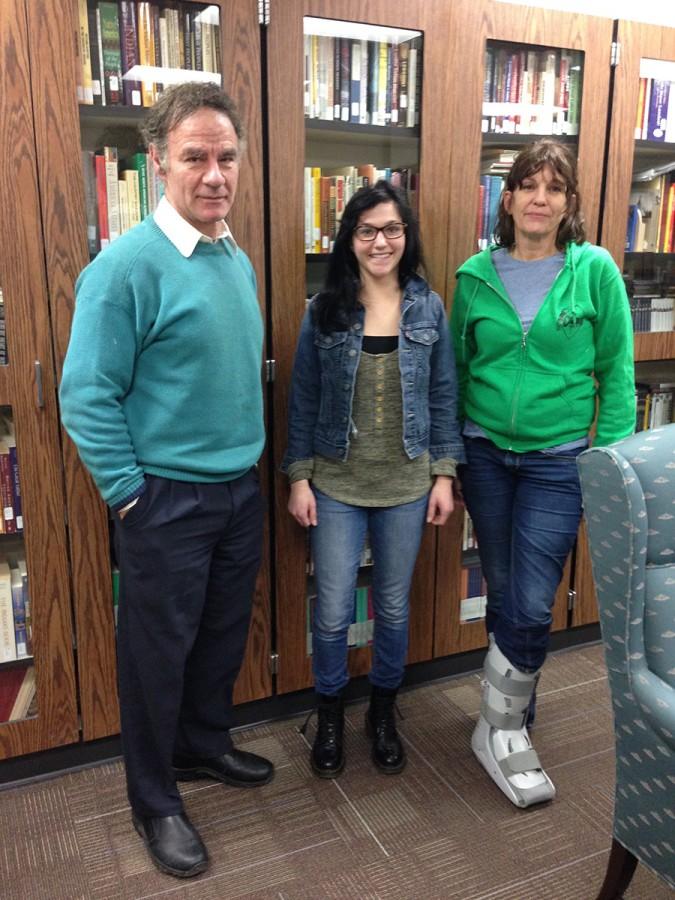Different perspectives on frac sand mining
UW-Eau Claire researchers and stake holder in the industry discuss frac sand mining
More stories from Stephanie Kuski
Photo by Stephanie Kuski
UW-Eau Claire associate professor Crispin Pierce and student researchers Maryanne Cowart and Hannah Brown discuss fracking.
Dr. Crispin Pierce and his team of student researchers assessed possible health risks fracking sites may pose to surrounding residents, Pierce said.
Pierce, an associate professor of environmental public health at UW-Eau Claire, defines hydraulic fracturing, or fracking, as the process where sand, water and hydrocarbon additives are injected into the ground in order to extract oil and gas, according to his published research.
Pierce and his team of student researchers measured the airborne particulates around
fracking sites in order to assess possible respiratory problems it may pose to residents and
workers. His team compares this data to local DNR data collections which do not measure the air quality at the fracking sites themselves.
Wisconsin is a prime area for silica sand which is used in the fracking process. However, if this sand is not handled properly, it can pose health risks during the digging process, Pierce said.
“The dangerous stuff is what’s in the air that got left behind,” Pierce said.
After two years of studying the conditions around the frac sand mining site in Bloomer, Wis., Pierce said although there is elevation in the amount of harmful dust near frac sites, there is not enough evidence to conclude that the dust will pose detrimental health risks
“So the idea is that they are breathing in a little more dust and are more likely to have an allergic reaction or asthma attacks or bronchitis,” Pierce said, “and the risk of cardiovascular and heart disease over time is raised a little bit.”
Digging up the sand, a process known as strip mining, disturbs the soil structure of farmland and can take up to 25 years to be replenished, Pierce said.
“When you strip mine, you remove the soil and everything else that’s alive dies or moves,” Pierce said. “Soil structure, plants, animals, everything is gone.”
On a politically charged manner, Pierce said he’s trying to stay as scientifically-minded as possible.
Maryanne Cowart, a senior environmental public health major involved in Pierce’s team of
student researchers, also said she tries to remain open-minded.
“If a mine supports the well-being of the community members and doesn’t put them at risk, then it’s a benefit,” Cowart said.
On the other hand, for some, like junior marketing major Nate Pientok, whose family has been involved in the frac sand industry for well over a decade, frac sand mining has its economic benefits.
Pientok said sand fracking has created jobs in rural towns across Wisconsin, a growth of three to four thousand jobs on one site alone. Pientok also said sand allows extraction of 90-95 percent of oil, while oil deposits that do not use frac sand only extract 60-65 percent of the oil.
People are unfamiliar with the subject of frac sand mining, Pientok said, especially in terms of its strict regulations at the state and local level, through town boards and city councils.
Pientok said much of the controversy surrounding sand fracking is a result of the
devastation fracking had during the industry’s onset in the forties, where harmful chemicals
killed the nutrients and the vegetation above frac sites.
Pentik said others have the right to be hesitant about sand fracking because they have seen the worst of what it can do. But the industry has improved in environmental safety tenfold, especially with the use of silica sand, he said.
“People are so afraid of what has happened [in the past] that they refuse to take the next step
and see what is possible,” Pientok said.

